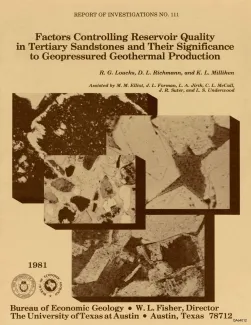
Publication Details
Geolocation:
Get the Publication
$9.00
Abstract/Description:
Variable intensity of diagenesis is the factor primarily responsible for contrasting regional reservoir quality of Tertiary sandstones from the upper and lower Texas coast. Detailed comparison of Frio sandstone from the Chocolate Bayou/Danbury Dome area, Brazoria County, and Vicksburg sandstones from the McAllen Ranch Field area, Hidalgo County, reveals that extent of diagenetic modification is most strongly influenced by (1) detrital mineralogy and (2) regional geothermal gradients.
Vicksburg sandstones from the McAllen Ranch Field area are less stable, chemically and mechanically, than Frio sandstones from the Chocolate Bayou/Danbury Dome area. Vicksburg sandstones are mineralogically immature and contain greater proportions of feldspars and rock fragments than do Frio sandstones. The reactive detrital assemblage of Vicksburg sandstones is highly susceptible to diagenetic modification. Susceptibility to modification is enhanced by higher than normal geothermal gradients in the McAllen Ranch Field area. Consolidation of Vicksburg sandstones began at shallower burial depth, and precipitation of authigenic phases (especially calcite) was more pervasive than in Frio sandstones. Moreover, the late-stage episode of ferroan calcite precipitation that occluded most secondary porosity in Vicksburg sandstones did not occur significantly in Frio sandstones. Therefore, the regional reservoir quality of Frio sandstones from Brazoria County is far better than that characterizing Vicksburg sandstones from Hidalgo County, especially at depths suitable for geopressured geothermal energy production.
However, in predicting reservoir quality on a site-specific basis, locally variable factors such as relative proportions of porosity types, pore geometry as related to permeability, and local depositional environment must also be considered. Even in an area of regionally favorable reservoir quality, such local factors can significantly affect reservoir quality and, hence, the geothermal production potential of a specific sandstone unit.